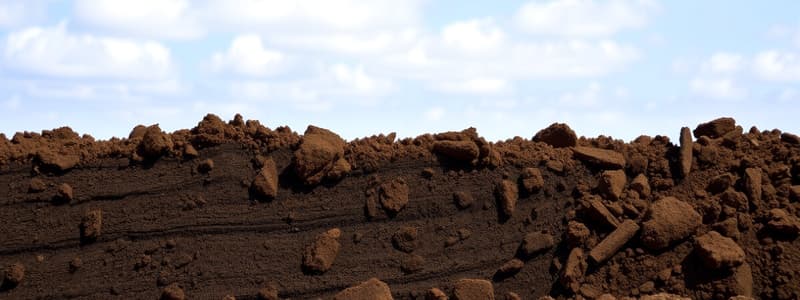Podcast
Questions and Answers
At shrinkage limit, degree of saturation (%) of soil is:
At shrinkage limit, degree of saturation (%) of soil is:
- 100% (correct)
- 0%
- Between 0 and 100%
The two major soil classification systems, AASHTO and USCS, classify soils using the information on soil's:
The two major soil classification systems, AASHTO and USCS, classify soils using the information on soil's:
- Expansion and shrinkage
- Water content and density
- Void ratio and origin
- Gradation and plasticity (correct)
The Unified Soil Classification System is based on:
The Unified Soil Classification System is based on:
- Grain size distribution and color
- Grain size distribution and plasticity (correct)
- Grain size distribution only
- None of the above
Granular soil materials are generally better as compared to fine-grained soil as subgrade materials.
Granular soil materials are generally better as compared to fine-grained soil as subgrade materials.
Which of the following soils is organic soil?
Which of the following soils is organic soil?
A soil is classified as SW with the USCS method. The symbol SW means that the soil is:
A soil is classified as SW with the USCS method. The symbol SW means that the soil is:
A soil is classified as ML with the USCS method. The symbol ML means that the soil is:
A soil is classified as ML with the USCS method. The symbol ML means that the soil is:
Soil has properties: Liquid Limit = 40.0%; Plastic Limit = 20.0%; % retained on No. 4 sieve (or % gravel) is:
Soil has properties: Liquid Limit = 40.0%; Plastic Limit = 20.0%; % retained on No. 4 sieve (or % gravel) is:
The coarse fraction of the soil is:
The coarse fraction of the soil is:
Soil has properties: Liquid Limit = 40.0%; Plastic Limit = 20.0%; % fines in the soil:
Soil has properties: Liquid Limit = 40.0%; Plastic Limit = 20.0%; % fines in the soil:
Soil has properties: Liquid Limit = 40.0%; Plastic Limit = 20.0%; The plasticity index (PI) of the soil is:
Soil has properties: Liquid Limit = 40.0%; Plastic Limit = 20.0%; The plasticity index (PI) of the soil is:
With USCS method, the soil is classified as:
With USCS method, the soil is classified as:
AASHTO soil classification system is commonly used in:
AASHTO soil classification system is commonly used in:
A soil is classified as 'A-3'. This classification is a result of:
A soil is classified as 'A-3'. This classification is a result of:
Use the AASHTO method to classify the soil with the following properties: LL = 48, PI = 30, % Passing No. 200 sieve = 41%.
Use the AASHTO method to classify the soil with the following properties: LL = 48, PI = 30, % Passing No. 200 sieve = 41%.
Classify soil with the following data: Liquid Limit = 42.3%; Plastic Limit = 15.8%; With USCS method, the soil is classified as:
Classify soil with the following data: Liquid Limit = 42.3%; Plastic Limit = 15.8%; With USCS method, the soil is classified as:
Classify soil with the following data: Liquid Limit = 42.3%; Plastic Limit = 15.8%; What is the USCS group name of soil?
Classify soil with the following data: Liquid Limit = 42.3%; Plastic Limit = 15.8%; What is the USCS group name of soil?
Classify soil with the following data: Liquid Limit = 42.3%; Plastic Limit = 15.8%; Classify the soil with the AASHTO method:
Classify soil with the following data: Liquid Limit = 42.3%; Plastic Limit = 15.8%; Classify the soil with the AASHTO method:
Given the following information, classify this soil using the Unified Soil Classification System (USCS). Give the USCS Group Symbol:
Given the following information, classify this soil using the Unified Soil Classification System (USCS). Give the USCS Group Symbol:
Given the following information, classify this soil using the Unified Soil Classification System (USCS). Give the USCS Group Name:
Given the following information, classify this soil using the Unified Soil Classification System (USCS). Give the USCS Group Name:
Flashcards are hidden until you start studying
Study Notes
Soil Classification Fundamentals
- At the shrinkage limit, the degree of saturation of soil is 100%.
- The primary soil classification systems are AASHTO (American Association of State Highway and Transportation Officials) and USCS (Unified Soil Classification System), which classify soils based on gradation and plasticity.
Unified Soil Classification System (USCS)
- The USCS categorizes soil using grain size distribution and plasticity.
- SW designation indicates well-graded sand, while ML indicates silt with low plasticity.
Soil Types and Properties
- Granular soil materials are preferred over fine-grained soils for subgrade applications in pavements and roads.
- Organic soils are represented by peat, distinguishing them from silt, clay, and alluvial soils.
Liquid and Plastic Limits
- Key liquid and plastic limits can influence soil classification; a soil with a Liquid Limit of 40% and Plastic Limit of 20% will have a plasticity index (PI) of 20%.
- The percentage retained on a No. 4 sieve reflects the coarse fraction, which can be crucial for classification.
AASHTO Classification System
- AASHTO is widely used in highway construction, categorizing soil into different classes for suitability in road foundations.
- Classification results such as A-3 and A-7-6 arise from the AASHTO methodology, informed by Liquid Limit, Plastic Index, and sieve analysis results.
Classifying Soil Using Data
- Soil with Liquid Limit at 42.3% and Plastic Limit at 15.8% is classified under USCS as CL (lean clay), with the group name Sandy Lean Clay.
- For data leading to classification, the AASHTO group naming will depend on the properties extracted, impacting infrastructure design choices.
Summary of Classifications
- The USCS uses symbols like GW and GP for group symbols, where GP correlates to poorly graded gravel.
- Group names for soils (like Well Graded Gravel or Poorly Graded Gravel with Sand) assist engineers in determining appropriate engineering properties for construction tasks.
Importance of Sieve Analysis
- Sieve analysis affects the classification outcomes regarding granular and coarse fractions, shaping practical applications in geotechnical engineering.
- The relationship between liquid limits, plastic limits, and the percentage of fines is essential for understanding soil behavior under various conditions.
Studying That Suits You
Use AI to generate personalized quizzes and flashcards to suit your learning preferences.





